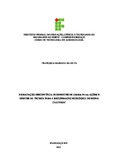Hidratação descontínua de sementes de libidibia férrea: ações e efeitos da técnica para a recuperação ecológica do bioma caatinga

Visualizar/
Data
2023-02-13Autor
Silva, Francisca Mariana da
http://lattes.cnpq.br/3554449951083866
Metadado
Mostrar registro completoResumo
The use of hydration and dehydration cycles can help seeds from dry forests, in the survival
rate during long periods of drought and drought, preserving biochemical and physiological
changes. In this sense, the objective was to evaluate the effect of discontinuous hydration cycles
during the germination process in Libidibia ferrea seeds under simulated water stress, as well
as to characterize changes in the structure generated from this process. For this, seeds of these
species were submitted to 0 (without hydration), 1, 2 and 3 cycles of hydration and dehydration,
with subsequent germination under simulated water stress for osmotic potentials 0.0 (distilled
water); -0.2; -0.4; -0.6 and -0.8 MPa. The design used was completely randomized in a 4 x 5
factorial arrangement (discontinuous hydration cycles x water potentials) with four replications
of 25 seeds for each treatment. The percentage and speed of germination, first count, digital
seedling length, seedling morphology and morpho-anatomical characterization were evaluated.
Having understood the three-phase process of germination of Libidibia ferrea seeds, it is
expected that at the end of the experiment the discontinuous hydration cycles will be able to
determine a greater resistance to simulated water stress conditions, as well as a maximization
of the germination time of the treated seeds, when compared with the control (without
application of hydration cycles).



